Manual therapy is based upon seeking out the underlying mechanism of dysfunction and eliminating that mechanism through hands-on treatment. Hands-on treatments may include joint mobilizations, manipulations, muscle energy techniques, myofascial release, and soft-tissue mobilization.
The goal of manual therapy is to decrease pain and increase flexibility. Clinicians reach this goal by using their hands to put direct pressure on a patient’s muscles and joints in order to manipulate them into proper positions. Manual therapy is often combined with exercise, modalities, and education to help a patient return to full function and prevent future injury.
Different disciplines of study within manual therapy include: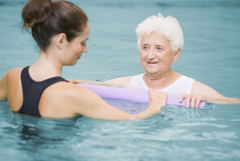
Aquatic therapy offers an alternative environment for therapeutic exercise. If you have tried traditional physical therapy or have restrictions on your physical therapy program, aquatic therapy may be the perfect solution for your physical therapy needs. Patients with orthopedic and arthritic conditions can stretch and strengthen in an impact reduced environment. If you have a restricted weight-bearing status after surgery, aquatic therapy may also be ideal for you. The buoyancy of water reduces the stress of gravity so you can exercise in water, even if you have partial weight-bearing status.
Three unique features to aquatic therapy: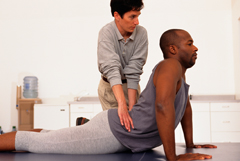
The McKenzie Method, aka Mechanical Diagnosis and Therapy (MDT), is a philosophy and system of active patient involvement and education for patients with back, neck, and extremity problems. It empowers the patient in self-treatment and prevention. It is used worldwide and is one of the most researched physical therapy methods available. The McKenzie Method has been shown to have superior outcomes using fewer visits, modalities, and tests, making it extremely cost effective for the patient.
Physical therapists that are certified in the McKenzie Method can effectively use mechanical assessment to address each patient’s pain. The most common and meaningful response to look for is centralization. Centralization is defined as referred or radiating pain which promptly reverses and moves back towards the center of the spine and then decreases. The literature now documents centralization as an important diagnostic tool and favorable prognostic indicator. Research has shown that the mechanical assessment performed by a certified McKenzie therapist is as reliable as an MRI to determine the source of the problem and quickly identify those patients who will or will not respond to treatment.
Another major component of McKenzie is patient education and self-treatment. It is so effective, that a number of third-party payers across the country have made McKenzie their treatment of choice and even demand that all of their spine patients be seen by McKenzie–trained therapists. McKenzie can be applied to any part of the body, not just the spine. It promotes the body’s potential to heal itself without complete dependence on the practitioner.
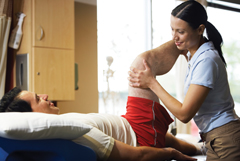
Strain and Counterstrain (SCS) is a manual therapy technique that was developed in the 1950’s by an osteopathic physician named Lawrence Jones. It is a gentle non-traumatic technique that uses passive body positioning of spasmed muscles and/or dysfunctional joints toward positions of comfort. SCS is effective because treatment moves the body away from the painful restricted directions of motion. Treatment is guided by what feels good to the patient and often dramatic changes are made in decreased pain, muscle guarding, and swelling.
SCS is a gentle method of detection and correction that encourages the body’s own natural healing processes. The changes that occur with SCS facilitate a faster and more complete recovery. SCS has an extremely broad application for physical ailments and can be used for acute, traumatic, or more chronic conditions. Its value is unmatched because it is gentle and non-traumatic. SCS will treat long-standing neuromuscular problems by reducing the tone of a muscle in spasm, decreasing pain, and normalizing joint function. SCS is safe and effective for a multitude of pain and dysfunction including but not limited to:
To become certified in the Strain Counterstrain technique, licensed healthcare professionals must successfully complete a Jones Institute SCS course series and exam and have at least two years of patient care experience. The Jones Institute is the only organization that provides instructors who are certified and authorized to teach the Strain Counterstrain (SCS).
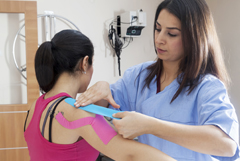
KINESIO TEX TAPE is a unique, latex free tape that aids in the rehabilitation of patients for multiple medical conditions. The weight, thickness, and elasticity of the tape mimic that of normal human skin. The concept of Kinesio tape was developed by Dr. Kenzo Kase. Dr. Kase worked with a team of scientists to help create Kinesio Tex tape over 30 years ago. In 1984, Dr. Kase founded the Kinesio Taping Association in Japan. Today the Kinesio Taping Association has members in over 30 countries worldwide. The Association hosts and regulates symposia and seminars to educate medical professionals all over the world. Kinesio tape was first introduced into the United States in 1995, but did not become popular until the 2008 Olympics.
Kinesio tape has a distinct fingerprint design which helps move with the body to correct improper biomechanics and act in restoring the body’s normal function. Unlike typical athletic tape, which can restrict the joint and apply pressure to the affected area, Kinesio tape is designed to allow the body its available range of motion while promoting positive blood circulation. The skin-like design also allows the patient’s skin to breathe and enables up to 5 DAYS OF WEAR TIME. Kinesio tape can be worn by patients of all ages. The tape’s special qualities enable it to be worn while swimming and showering. The adhesive used in Kinesio tape is heat activated and works with the patient’s body heat to remain intact. Most athletes find Kinesio tape comfortable and easy to wear because it does not inhibit their movement while supporting the injury.
Kinesio tape is typically used in conjunction with other treatments and modalities. It is most widely used by physical therapists, occupational therapists, and chiropractors. After a medical professional completes their evaluation, they will determine how the tape will best be utilized.
Kinesio tape can help:Whether you are preparing for surgery, trying to rehabilitate post-operatively, or getting back to walking or sports after an injury, Kinesio taping may help you in the process. It helps provide carryover treatment provided by the therapist, increasing recovery speed for patients. The concept of Kinesio taping can be applied to any joint and most areas on the body.
It is important that the Kinesio tape initially be applied by the appropriate medical professional to best utilize its abilities. Physical & occupational therapists can be trained and certified in these taping techniques. They will typically conduct an evaluation and determine the best course of treatment. Professionals can use Kinesio taping in conjunction with other modalities and exercises in the clinic or at home.
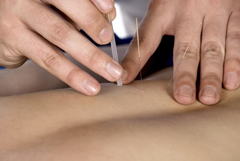
Trigger point dry needling uses small, thin needles to stimulate underlying myofascial trigger points, muscular and connective tissues for the management of both acute and chronic orthopedic conditions. By inserting a needle into the damaged tissue, it often leads to a contraction of the muscle which then stimulates a release. This leads to a reduction of pain, improvements in flexibility and a restoration of normalized movement when combined with corrective exercises.
A myofascial trigger point is a hyperirritable spot within a taut band of skeletal muscle that produces local or referred pain. The trigger point can lead to increased pain, decreased flexibility and decreased muscle function if not treated. Trigger point dry needling is a safe, effective, and efficient treatment technique to release these painful spots.
Muscle dysfunction can be the primary or secondary contributing factor to many neuromusculoskeletal conditions, which can include:
This treatment is not acupuncture. Modern dry needling is based on Western neuroanatomy and modern scientific study of the muscles and nervous system. This modality can only be done by trained clinicians.
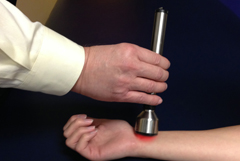
The Cold Laser is a handheld, non-invasive, low energy, therapeutic laser. It produces light which penetrates up to 2 inches into the body. In human tissue, the resulting photochemical reaction produces an increase in the cellular metabolism rate that expedites cell repair and the stimulation of the immune, lymphatic, and vascular systems. The net result, observed in clinical trials, is the apparent reduction in pain, inflammation, edema and an overall reduction in healing time. It generates NO heat and is safe for use on any area of the body except the eyes.
Pain relief is often felt on the first visit, but may take up to 10 visits for complete results. The results can be permanent as it promotes true tissue healing.
Treatment can be done in conjunction with other therapy or by itself. An individual laser treatment can last from 5 to 30 minutes depending on the number of areas treated and whether it is an acute or chronic condition.
Perhaps the most appealing single factor about this unit is the possibility that it may help conditions where previous therapies have failed.
Conditions that can be treated by a cold laser include: